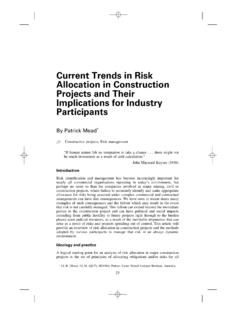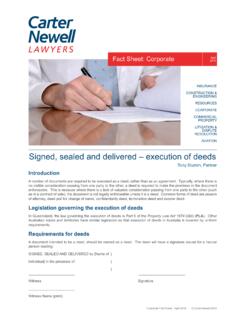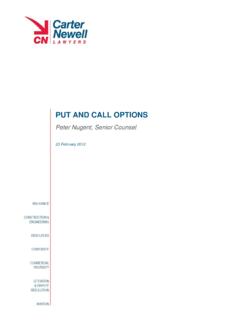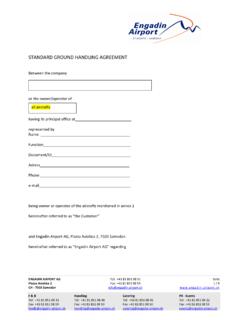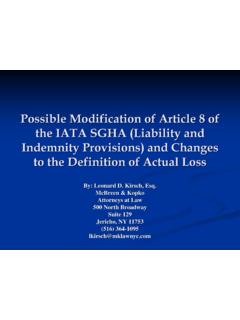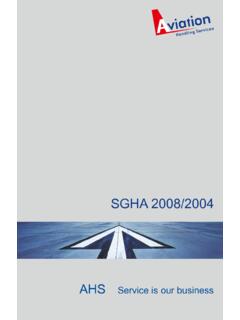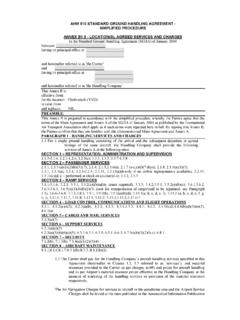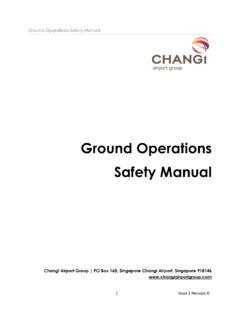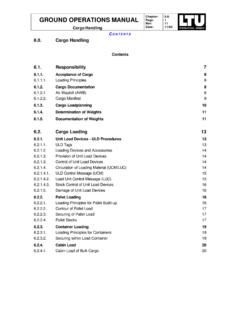Transcription of Aviation February 09 - Carter Newell
1 The IATA1 Standard ground handling Agreement (SGHA) is a document that is reviewed and produced on a five yearly basis to respond to the needs of the continually evolving business of ground handling . While businesses are contractually free to agree to whichever SGHA they choose, many are now migrating from the previous versions (1998 and 2004) to the 2008 version. With this in mind, it is timely to consider the changes to Article 8 Liability and Indemnity of the 2008 SGHA and the legal implications arising from those changes. There are two amendments to Sub-Article 8 which we discuss below: Alterations to the final paragraph of Sub-Article ; and, The insertion of a new Sub-Article, Sub-Article of the 2008 SGHA The terms of Sub-Article of the 2008 SGHA are as follows: '..PROVIDED ALSO THAT where any of the services performed by the handling Company hereunder relate to the carriage by the Carrier of passengers, baggage or cargo, then if the limitations of liability imposed by the Warsaw Convention and/or the Montreal Convention (1999) as applicable and as amended from time to time would have applied if any such act or omission had been committed by the Carrier but are held by a Court not to be applicable to such act or omission committed by the handling Company in performing this Agreement then upon such decision of the Court the indemnity of the Carrier to the handling Company hereunder shall be limited to an amount not exceeding the amount for which the Carrier would have been liable if it had not committed such as or omission'.
2 Previously Sub-Article only applied to the carriage of passengers, baggage or cargo direct to or from a place in the USA . That limit has been removed from the 2008 SGHA and the previous reference to the Warsaw Convention has been widened with Sub-Article now including a reference to both the Warsaw Convention and the Montreal Convention (1999). From a legal perspective, Sub-Article is now wider than before. The removal of the reference to the carriage of passengers, baggage or cargo direct to or from a place in the USA opens the application of the Article to global air carriage. For example, under the 2004 SGHA the provision of ground handling services in Australia to a European Carrier, transporting passengers, baggage or cargo to London via Singapore would not have been affected by this provision. Under the 2008 SGHA, this is no longer the case and the terms of Sub-Article could equally apply to the provision of ground handling services to a class of Carrier previously excluded by the narrow wording of Sub-Article Another example reflective of the widening of Sub-Article is found in the inclusion of the Montreal Convention (1999)2.
3 By extending the terms of the Article to include the Montreal Convention, the provisions of the more recent convention are enlivened. The integration of the Montreal Convention into the 2008 SGHA is important because the Montreal Convention modernised the core provisions of the Warsaw regime so as to take account of the changing international air transport environment. It is also a recognition that the Montreal Convention is now in force in many countries, including Australia. Sub-Article of the 2008 SGHA Sub-Article is a completely new insertion into the 2008 SGHA. The terms of the Sub-Article are as follows: Furthermore, nothwithstanding Sub-Article (c), the handling Company shall indemnify the Carrier against direct loss of or damage to the Carrier s cargo (excluding Mail) caused by the negligent act or omission by or on behalf of the handling Company (writers emphasis) in the provision of the services and/or the supply of goods under this Agreement PROVIDED ALWAYS THAT the handling Company s liability shall be limited to 17 SDR per kilo or to the actual compensation paid out by the Carrier, whichever is less.
4 In any event, the total amount of the claim shall not exceed USD 1,000,000 except that loss or damage in respect of any claim below USD500 shall not be indemnified. Any claim shall be submitted within the time limits of the Warsaw Convention. For the avoidance of 1 In Brief There is currently a lot happening in Australian Aviation ! This edition of Carter Newell 's Aviation Newsletter addresses some of these new developments including the announcement of two major airport terminal expansion projects, the commencement of the new Civil Aviation Legislation Amendment (1999 Montreal Convention and Other Measures) Act 2008 and shifting liabilities under the IATA Standard ground handling Agreement (2008). by Paul Hopkins, Senior Partner What's Airport terminal expansion approvals for Brisbane and Darwin Making the air fair The Civil Aviation Legislation Amendment (1999 Montreal Convention and Other Measures) Act 2008 News just Carter Newell wins the Queensland Law Society Employer of Choice Award 2008 Staff ALAANZ Conference 28th Annual Conference February 2009 Shifting liabilities: IATA Standard ground handling Agreement (2008) by Shannon O Hara, Associate Aviation Commercial Dispute Resolution Corporate & Commercial Construction & Engineering Insurance doubt, the liability of the handling Company shall never exceed the liability of the Carrier.
5 In a departure from the previous SGHA which limited the liability of ground handling businesses, this new Sub-Article sees the potential liability of ground handling businesses enlarged. Under the terms of Sub-Article , despite the provisions of Sub-Article , ground handling service providers are required to indemnify Carriers for direct loss or damage to cargo caused by: negligent acts or omissions in the provision of services by the ground handling business to the Carrier; and/or, negligent acts or omissions in the supply of goods. However, any liability is expressly limited by the wording of the Sub-Article to whichever of the following two is less: 17 Special Drawing Rights3 (SDRs) per kilo (approximately AUD40); or The amount of actual compensation paid by the Carrier. Following on from this is an additional proviso that despite the limits outlined above, the total of any claim by a Carrier cannot exceed USD1million and that any losses falling below USD500 will not be indemnified.
6 This unbreakable limit creates in the SGHA consistency with the terms imposed by the Montreal Convention on Carriers and their servants or agents (which would include ground handling service providers). How will the changes affect providers? ground handling service providers ought to be aware of these important changes and how they will impact on their business. For example new business partnerships may require the use of the 2008 SGHA agreement. If so ground handling service providers should consider questions such as are we prepared to accept an increased liability to carriers? , are we adequately insured in light of the enlarged liability exposure of ground handling service providers? , and if a claim is advanced against a ground handling service provider, does a liability exist? These are but a few examples of the types of considerations that could impact on the provision of ground handling services under the 2008 SGHA.
7 If you would like more information on the changes to the 2008 SGHA or in relation to claims by Carriers under any of the SGHA s, please do not hesitate to contact one of our specialist Aviation team members. 1 international Air transport association . 2 Formally the Convention for the Unification of Certain Rules for international Carriage by Air. 3 SDRs are used as a unit of account by the international Monetary Fund and several other international organisations. SDRs are defined in terms of a basket of major currencies used in international trade and finance. At present, the currencies in the basket are the Euro, the Pound Sterling, the Japanese Yen and the United States Dollar. Airport terminal expansion approvals for Brisbane and Darwin by Shannon O Hara, Associate On 5 February 2009, the Minster for Infrastructure, transport , Regional Development and Local Government, announced two significant airport terminal expansion approvals in Brisbane and Darwin4.
8 In Brisbane, the terminal expansion will occur at the Domestic terminal. In accordance with the Brisbane Airport Master plan, the terminal expansion will comprise construction of a new check-in hall and expansion of the northern end of the terminal with additional gate lounges and retail space . Outside the terminal the road networks providing access to the domestic terminal will be reconfigured, the common-user satellite will be expanded with up to seven new gates and a new central energy plant will be constructed to provide for present and future energy needs at the terminal . The half billion dollar upgrade project will be the most significant works project undertaken at the Brisbane Airport since it opened in 1988 and is designed to take account of an increase in expected domestic passenger numbers from million to 34 million by 2030. In Darwin the $60 million terminal expansion project will take place at both the Domestic and international terminals.
9 The proposed design incorporates a multi-level expansion project comprising: Check-in processing areas, international inbound processing facilities and security screening areas on the ground floor; Domestic and international departure, domestic and international aircraft access via fixed/apron driver aerobridges and/or undercover walkways and expanded retail outlets; and Airline lounges on the second floor. The expansion project will also provide for the creation of additional car parking facilities and a dedicated goods delivery area . It is anticipated that the expansion project will ensure the Darwin Airport will be in a position to continue to service the needs of the increased number of passengers (from million to over 4 million) expected to transit through the Airport between now and 2030. 4 Media Release, Brisbane Airport Domestic Terminal Expansion Approved , The Honourable Anthony Albanese MP at Media Release, Darwin Airport Terminal Expansion Approved , The Honourable Anthony Albanese MP at 2 Making the air fair The Civil Aviation Legislation Amendment (1999 Montreal Convention and Other Measures) Act 2008 by Shannon O Hara, Associate On 24 January 2009, the Civil Aviation Legislation Amendment (1999 Montreal Convention and Other Measures) Act 2008 (C th) (the Act) commenced5.
10 The introduction of the Act sees the terms of the Convention for the Unification of Certain Rules for international Carriage by Air entered into at Montreal on 28 May 1999 (Montreal Convention) introduced into Australian Law, some ten years after the Convention. The Act applies to international air carriage between Australia and other countries which have implemented the Convention. This includes the USA, China, New Zealand, the UK and most European Union countries. It imposes a tougher liability regime on airlines for the death or injury of a passenger, loss or damage to a passenger s luggage, loss or damage to a freight shipment and delays to the arrival of a passenger s baggage or freight 6. The Act provides for unlimited liability for death and personal injury. This operates via a two-tiered system which provides for: Claims on a strict liability basis with damages capped at 100,000 Special Drawing Rights7 (SDRs) (approximately AUD225,000); or Unlimited damages unless the carrier proves that it was not negligent or that the damage was due solely to the negligence of a third party in which case the carrier may limit recovery to 100,000 SDRs (approximately AUD225,000)8.
